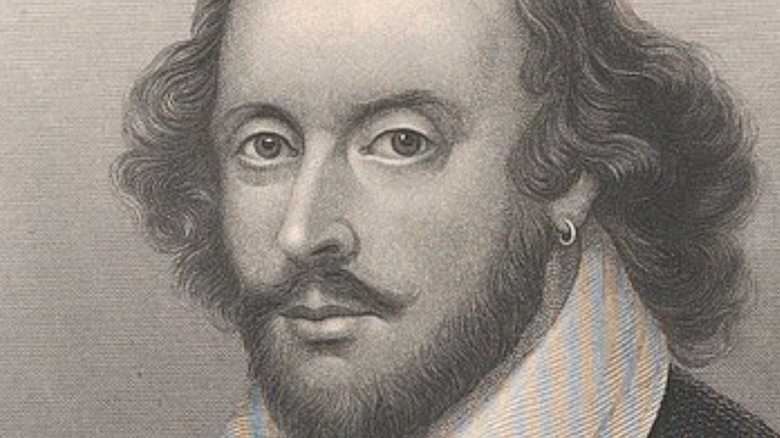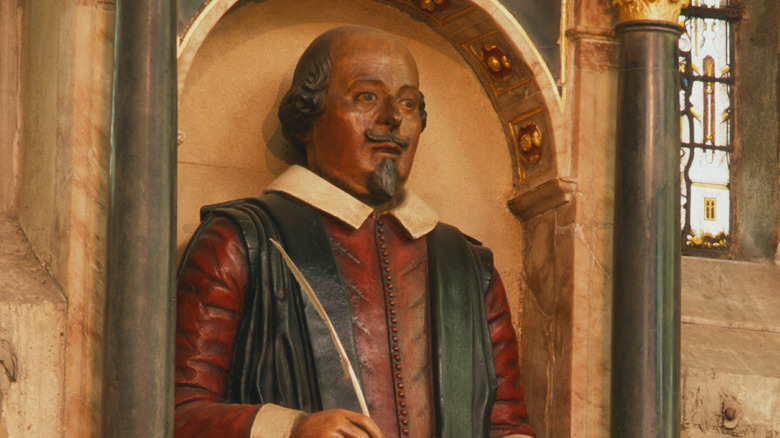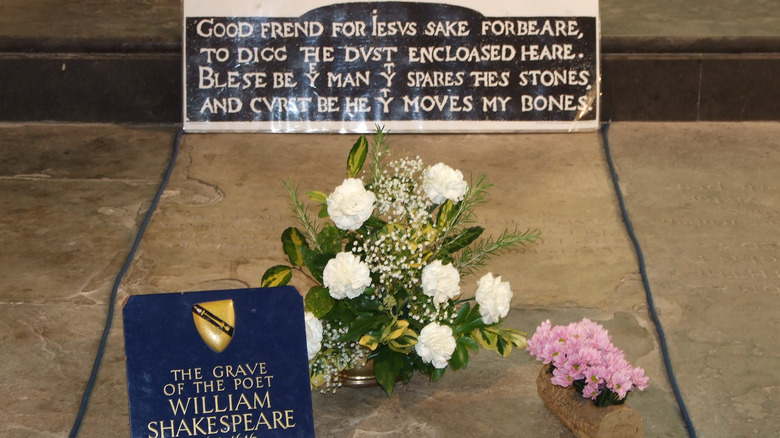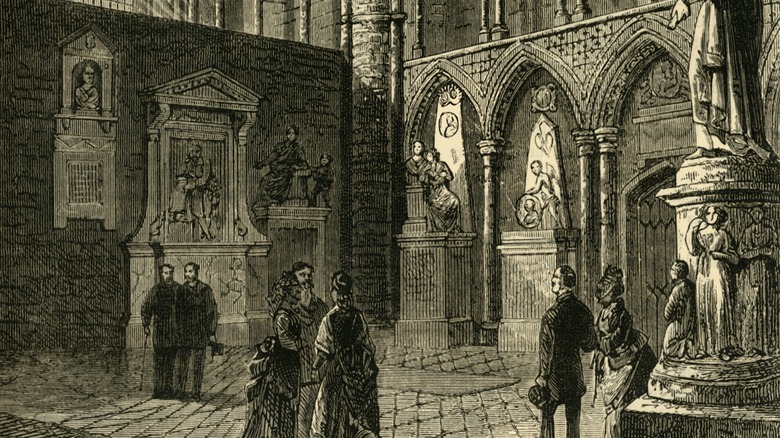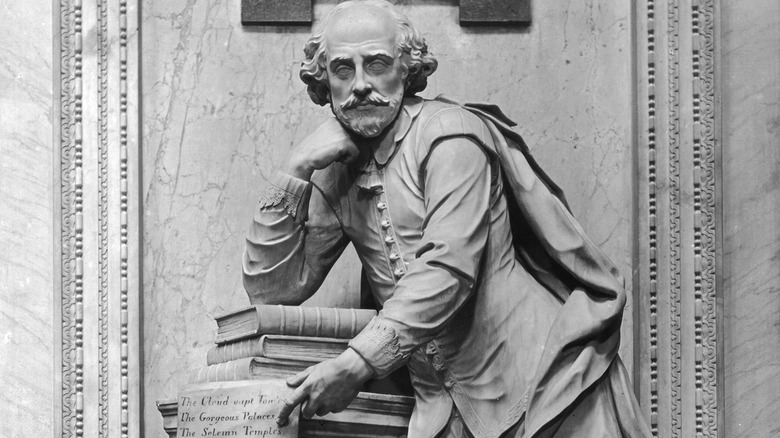The Truth About Where William Shakespeare Is Buried
William Shakespeare is remembered every time one of his plays is performed on stage, adapted into a teen movie, assigned on a high school syllabus, or even quoted by young people eager to impress their crush. However, if you want to pay your respects to the author who coined more than 1,700 English words — including alligator, critic, and eyeball — there are two physical sites you can visit (via Shakespeare Birthplace Trust).
Shakespeare was buried in Holy Trinity Church in his home town of Stratford-upon-Avon in 1616, according to Stratford Blog. For Shakespeare, burial was a homecoming. His final resting place was also the church where he was baptized in 1564. It is also most likely the place where he attended services growing up and again when he retired, according to the church website. He can now attend services for all eternity in the church's chancel alongside his wife, Ann Hathaway; his daughter, Suzanna; her husband, Dr. John Hall; and his granddaughter's first husband, Thomas Nash.
Funeral rights
William Shakespeare wasn't buried in Holy Trinity Church because the church wanted to honor its native son. Instead, Shakespeare had purchased the right to a burial spot by buying a stake in the maintenance of the church's chancel for £440 in 1605, the church website said. This is also why his family members were later buried beside him. Shakespeare apparently didn't take his duties very seriously, because the chancel was reportedly rather run down in the years after his death.
While Shakespeare's grave didn't begin as a memorial to a famous poet, it became one over time. Just shortly after his death, while his wife, Ann, was still alive, a memorial was erected in his honor. He is depicted as tanned, and the likeness is supposed to be relatively accurate. Today, anyone can visit the chancel that houses the grave for a donation of £3, according to the Stratford Blog. The church website says that hundreds of people come to visit the grave every year, and this helps pay to keep the church running.
A curse and a mystery
William Shakespeare left behind a final message. His grave reads, "Good friend for Jesus sake forbeare, To dig the dust enclosed here. Blessed be the man that spares these stones, And cursed be he that moves my bones" (via the Canada College Library). Curses like these were relatively common in Shakespeare's day to deter graverobbers. In addition, when a graveyard ran out of space, people would often dig up the old bones and discard them to make room for the newly deceased, according to the Holy Trinity Church website. The church chancel was actually once located near a charnel house where such bones were discarded, and Shakespeare wanted to make sure his remains were not treated with such disdain.
For the most part, Shakespeare's warning has proven effective, according to the Canada College Library. Construction workers in 2008 made sure to fulfill their mandate without shifting the Bard's bones. However, in 1879, The Argosy magazine printed a story that graverobbers had stolen Shakespeare's skull one century before, Reuters reported. In the 18th century, people thought that genius could be detected from a person's remains. For many years, however, the skull-robbery story was dismissed as an urban legend. Then, in 2016, a team of archaeologists conducted a ground-penetrating radar scan of the grave, according to BBC News. They found evidence of disturbance where the skull would lie. "It's very, very convincing to me that his skull isn't at Holy Trinity at all," Staffordshire University archaeologist Kevin Colls told BBC News.
Poets' corner
In addition to his official grave, there is another important memorial to William Shakespeare. This is located in Poets' Corner in Westminster Abbey, according to the abbey website. Poets' Corner refers to a part of the abbey where many famous authors are buried. The tradition started because Geoffrey Chaucer, the medieval author of "The Canterbury Tales," was laid to rest in the abbey's South Transept (via Shakespearean London Theatres). Then "The Faerie Queene" author Edmund Spenser was also buried in a similar part of the church. The pair was then joined by famous Elizabethan playwrights Ben Jonson, Francis Beaumont, Michael Drayton, and William Davenant.
After Shakespeare died, some thought his remains should also be housed in Poets' Corner, according to the Westminster Abbey website. Contemporary poets even floated the idea in verse. "Renowned Spenser, lie a thought more nigh to learned Chaucer; and rare Beaumont, lie a little nearer Spenser, to make room for Shakespeare," the poet William Basse wrote. Ben Jonson, however, disagreed, arguing that Shakespeare was too good to be entombed as just another poet. "My Shakespeare, rise! I will not lodge thee by Chaucer, or Spenser, or bid Beaumont lie A little further, to make thee a room: Thou art a monument without a tomb, And art alive still while thy book doth live And we have wits to read and praise to give," he wrote in the poem "To the Memory of My Beloved the Author, Mr. William Shakespeare" (via Poetry Foundation).
Westminster memorial
In the end, William Shakespeare's remains were not relocated to Poets' Corner in Westminster Abbey. However, in 1726, the Dean and Chapter of the abbey agreed that a monument to the Bard could be built inside the edifice, according to the abbey website. That monument was finally installed on January 29, 1741. The statue was planned by William Kent and actually carved by Peter Scheemakers. It is made of white marble and features Shakespeare standing with one leg crossed over the other and leaning on a pile of books placed on a pedestal. He stands five feet, six inches and is dressed in Elizabethan garb.
The busts of three English monarchs are built into the pedestal Shakespeare leans upon: Queen Elizabeth I, Henry V, and Richard III. Above Richard III's head, there is a ring of bay leaves symbolizing immortality, a dagger symbolizing tragedy, and a dramatic mask. A scroll unfolds from under the books, on which lines from "The Tempest" are painted. The quote is a variation on a speech from Prospero and reads, "The Cloud capt Tow'rs, The Gorgeous Palaces, The Solemn Temples, The Great Globe itself, Yea all which it Inherit, Shall Dissolve; And like the baseless Fabrick of a Vision Leave not a wreck behind." But the quote itself is proof that something of Shakespeare's has remained centuries later: his words. Even though there are two monuments that admirers can visit, Ben Jonson was ultimately correct. Shakespeare is "a monument without a tomb."
